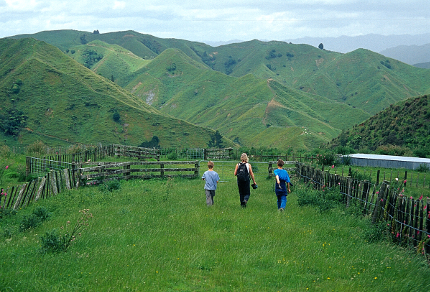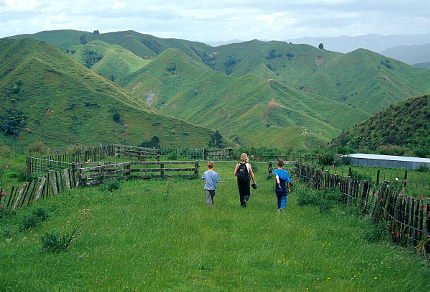Use specific, concrete details to take sensory impressions from nature to your novel, using the natural world as fiction backdrop and adding punch and reality to your writing.
As a writer, I’ve often heard the advice, “Write what you know.” It’s good advice, particularly when applied to non-fiction. However, writers can also move from nature to novel and use the natural world as fiction backdrop.
To craft my travel memoir trilogy, Cry of the Kiwi: A Family’s New Zealand Adventure, I pored over personal journal and nature journal entries I’d written in New Zealand. I meticulously went through every notebook I’d filled with notes about my family’s outdoor adventures. I studied hundreds of photographs that my husband, Vilis, and I had taken. All these resources helped me to paint a clear picture of New Zealand’s spectacular landscapes and intriguing flora and fauna, as well as aspects of Kiwi culture that Vilis, I and our sons had experienced during ten-and-a-half months in New Zealand.
My travel memoir trilogy is non-fiction. However, if I were to choose to write a novel set in New Zealand, I could use specific, concrete details from my journals, notebooks and photographs to lend reality to my fiction. I could move from nature to novel.
A few years ago, I attended a writing workshop presented by acclaimed Canadian author Michael Crummey. The biggest thing I took away from the workshop was that fiction is essentially a good lie. In order to be a good lie, fiction needs to be supported by truth to convince readers to believe it. That’s where details come into the picture. Specific, realistic details lay the groundwork for inserting what is not real. Michael said, “Good writers put the real world on paper…Most fiction is true with added elements.”
Recently, I finished writing my first novel, A Look Across the Sand. It’s a contemporary love story set in southwestern Manitoba, Canada. Specifically, it’s set on Turtle Mountain, where Vilis and I lived for three years while he researched skunks’ hunting habits for his doctoral thesis. Because I’m a birder and studied biology at university, I wanted the natural world to be a big part of my story. I wanted to go from nature to novel. So, I made the story’s heroine a wildlife photographer and incorporated real, true details of Turtle Mountain landscapes and wildlife into her outdoor adventures. I dug those details out of journals I’d kept and notebooks I’d filled with nature observations during our years in Manitoba.
At a mentoring session with another renowned Canadian author, Donna Morrissey, I told Donna that I love describing the natural world and asked her how I could fit that in with fiction writing. She cautioned me never to use description for description’s sake; rather, description – all those wonderfully specific, concrete, realistic details – must advance the story. I kept this in mind while writing my novel.
We are all people of our senses: sight, hearing, smell, taste, touch. As a fiction writer, my goal is to employ sensory perceptions of the natural world to create a rich and realistic backdrop for my story’s characters and plot. In essence, I want to move seamlessly from nature to novel and take captivated readers with me. These are readers who buy into the world I’ve created and feel the story.
Last spring, I presented a workshop on this topic to the Romance Writers of Atlantic Canada, in Halifax. To view the slides from my presentation, tap on Using the Senses.
Below, I’ve included a brief excerpt from A Look Across the Sand. I hope it illustrates the above points. I’d love to get your take on whether or not I’ve succeeded in going from nature to novel and using the natural world as fiction backdrop. You can leave a comment in the box at the bottom of this page. Thanks for dropping by my website!
A Look Across the Sand © 2017 Magi Nams
“On the south side of the access road, grass gave way to a ribbon of forest. Kimberley trod softly among towering aspens beside the creek, the morning air cool and fresh in the deep shade cast by the trees. She skirted a pool where she’d photographed a beaver reinforcing its dam a few weeks after her arrival on Turtle Mountain. A hundred meters farther on, a raccoon waddled away from the beaver-flooded waterway. The masked ring-tail climbed a tree and stared down at her.
She breathed deeply of the cool air, glad to be outdoors on foot, with her camera. This is who I am. Excitement skated through her as she wondered what images she would bring back to the old Steele place.
Two blue jays voiced strident alarm calls from atop the ravine edge and swooped into view ahead of her. What had set them off? An owl? A fox? With the awareness of someone who spends hours outdoors on a daily basis, Kimberley noted a sudden difference in the feel of the ravine. She froze into stillness in the shade, knowing that as long as she remained motionless, she would be virtually invisible. Her camouflage clothing and cap were a green and brown leaf-and-twig theme. Her pack, camera and binoculars were also covered with camo designs. She’d even daubed camo makeup on her face and hands and had tucked her long ponytail down the back of her shirt, heeding the advice Lincoln had given her after Lexi had been beaten. Be careful.
Yes, and what about Lincoln? Where does he fit into the picture? She pushed the thoughts away and, without moving her head, scanned the ravine banks and creek bed. A niggling feeling told her she wasn’t alone.”



